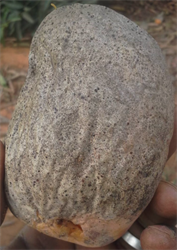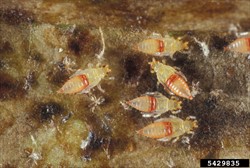Red-banded thrips. It is also known as the cocoa thrips.
Pacific Pests, Pathogens, Weeds & Pesticides - Online edition
Pacific Pests, Pathogens, Weeds & Pesticides
Mango red-banded thrips (519)
Selenothrips rubrocinctus; previously, it was known as Heliothripss rubrocinctus, and Physopus rubriocinctus.
Asia, Africa, North, South and Central America, the Caribbean, Oceania. It is recorded from American Samoa, Australia, Fiji, Guan, Kiribati, New Caledonia, Northern Mariana Islands, Papua New Guinea, Solomon Islands, Vanuatu, and Wallis and Futuna. Native to northern South America.
Mango and many other fruit species: avocado, Canarium, cashew, guava, mangosteen, rambutan, and more.
Adults and nymphs, mostly on the underside of new flushes of leaves, do the damage, They have mouthparts than brreak open the cells of the leaf and suck up the juices (Photo 1). Fruit is also attacked in the same way (Photos 2&3). The damage results in a silvery appearance on leaves and fruit Additionally, liquid excreted by the thrips falls onto foliage and fruit leaving brown or black spots as it dries (Photos 4-6). Large infestations may result in sooty moulds growing on the thrips excrement when it falls onto leaves below (see Fact Sheet no. 051). Severe damage leads to early leaf fall.
Over a period of about one month, females lay upwards of 50 eggs into the underside of the leaf, adding a drop of liquid each time, which dries to form a black cover. Within 4 days, the eggs hatch and the nymphs that emerge pass through two stages, growing to 1 mm in length over 9-10 days. Nymphs are creamy-yellow with two characteristic red bands around the middle (hence the name), and the tip of the abdomen is also red (Photos 2&3). After pre-pupae and pupae non-feeding resting stages, which last 3-4 days, the adults emerge. They are a little over 1 mm long, black with two pairs of feathery wings (Photos 7&8). The male is smaller, but is rarely seen, and the female produces eggs without fertilisation.
Spread is on the wind.
An important pest of many sub-tropical and tropical crops, first recorded on cocoa in the Caribbean. Sometimes, the symptoms appear to worsen during water stress with loss of leaves and drying of flowers. The browning and silvering of fruit can impact sales.
Look for the signs of thrips damage: silvery leaves and fruits (especially between fruit where they form clusters). Look for the distinctive black dots of dried faecal matter. Look for nymphs and adults on the underside of the leaves, particularly along the mid-veins of newly-hardened flushes. Especially look for the red-bands around the middle of nymphs: these are characteristic of this thrips species. Look between fruit clusters for aggregation of the red-banded thrips.
In South Africa, the possibility of using clustered fruits as traps rather than sticky cards has been suggested. A method using the ratio of clustered to single fruit was used to forecast percentages of rejected fruit.
BIOSECURITY
Selenothrips ribrocinctus is an important pest so countries not yet infested should consider potential pathways and apply quarantine measures accordingly. Particular attention should be given to the movement of nursery stock which may be infested with eggs, nymphs and adults, and fruit, especially any that show brown or silver patches, or with small black spots, which might harbour eggs.
NATURAL ENEMIES
Common predators, such as lacewings (see Fact Sheets nos. 270 and 406), predatory thrips, predatory bugs (e.g., pirate bugs, see Fact Sheet no. 086) and spiders, attack thrips. Green lacewings are available for commercial orchids. The weaver ant, Oecophylla sp., has been used with beneficial results in the Northern Territory, Australia (see Fact Sheet no. 386). (Note, this is not to suggest that the weaver ant be introduced into any country if not already present).
According to CABI, the egg parasitoid, Goetheana shakespearei, originally collected in Indonesia, has been introduced to Africa, the Caribbean, and Hawaii, for the control of the red-banded thrips and other thrips species.
CULTURAL CONTROL
Before plants:
- Plant windbreaks around fruit orchards to prevent infestation.
- Ensure good agronomic practices, for instance tree spacing, nutrition (but avoid excessive applications of nitrogen), irrigation and pruning, for healthy growth.
During growing:
- Avoid use of broad-spectrum insecticides, especially organophosphates that will destroy natural enemies.
- Monitor for presence of thrips by: (i) hanging blue sticky traps in trees (yellow traps are also effective); (ii) tapping foliage over a white plastic tray or white cloth and counting the thrips present.
CHEMICAL CONTROL
Avoid the use of broad-spectrum insecticides as they will destroy natural enemies, which under normal circumstances will control this thrips. If insecticides are required use the following:
- Use an aggregate pheromone: commercial products are available for western flower thrips which are recommended for several other thrips species. Add an insecticide to the lures.
- Use neem: (i) commercial preparations are available; and (ii) prepare from leaves and seeds using the recipe as follows: (see Fact Sheet no. 402).
- Use petroleum oils: they are used a 2% oil in water. The thrips need to be coated with a thin film of the oil-water solution to be effective.
- Use biological insecticides: Formulations of the fungi Metarhizum anisopliae or Beauveria bassiana.
- If monitoring finds that natural enemies are low, and thrips is damaging, use the broad-spectrum insecticide abamectin, derived from a soil-dwelling Streptomyces species. Alternatively, pyrethrum or synthetic pyrethroids.
____________________
When using a pesticide, always wear protective clothing and follow the instructions on the product label, such as dosage, timing of application, and pre-harvest interval. Recommendations will vary with the crop and system of cultivation. Expert advice on the most appropriate pesticides to use should always be sought from local agricultural authorities.
AUTHOR Grahame Jackson
Information from CABI (2021) Selenothrips rubrocincitus (red-banded thrips). Crop Protection Compendium. (https://www.cabi.org/cpc/datasheet/50265); Brown H, Chin D (2013) Red-banded thrips on fruit trees (Selenothrips rubrocinctus). Agnote 134. (https://industry.nt.gov.au/__data/assets/pdf_file/0019/233614/719.pdf); Denmark HA, et al. (2016) Redbanded thrips Selenothrips rubroconctus. Featured Creatures. Florida Department of Agriculture and Consumer Services, and University of Florida. (https://entnemdept.ufl.edu/creatures/orn/thrips/redbanded_thrips.htm); and CABI (2018) Red-banded thrips on cashew Selenothrips rubrocinctus. Plantwise Knowledge Bank. (https://www.plantwise.org/KnowledgeBank/pmdg/20187800833); and from Dennill GB, Erasmus MJ (1992) Basis for a practical technique for monitoring thrips in avocado orchards. Crop Protection, 11(1):89-91. Photo 1 Scot Nelson, University of Hawaii at Manoa, Budwood.org (https://www.forestryimages.org/browse/detail.cfm?imgnum=5446241). Photos 2&3 Pierre Silvie Identification of fruit mango problems. PestNet. (https://app.pestnet.org/submissions/view?submissionId=303c1957-4906-4aa2-832a-49586c38a26f). Photos 4-6 Lyle Buss, University of Florida, Bugwood.org. (https://www.forestryimages.org/browse/detail.cfm?imgnum=5429819, https://www.forestryimages.org/browse/detail.cfm?imgnum=5429835) and (https://www.forestryimages.org/browse/detail.cfm?imgnum=5429820). Photo 7 Mound L (2005) Red-banded Cocoa Thrips (Selenothrips rubrocinctus). PaDIL - http://www.padil.gov.au.
Produced with support from the Australian Centre for International Agricultural Research under project HORT/2016/185: Responding to emerging pest and disease threats to horticulture in the Pacific islands, implemented by the University of Queensland, in association with the Pacific Community.











